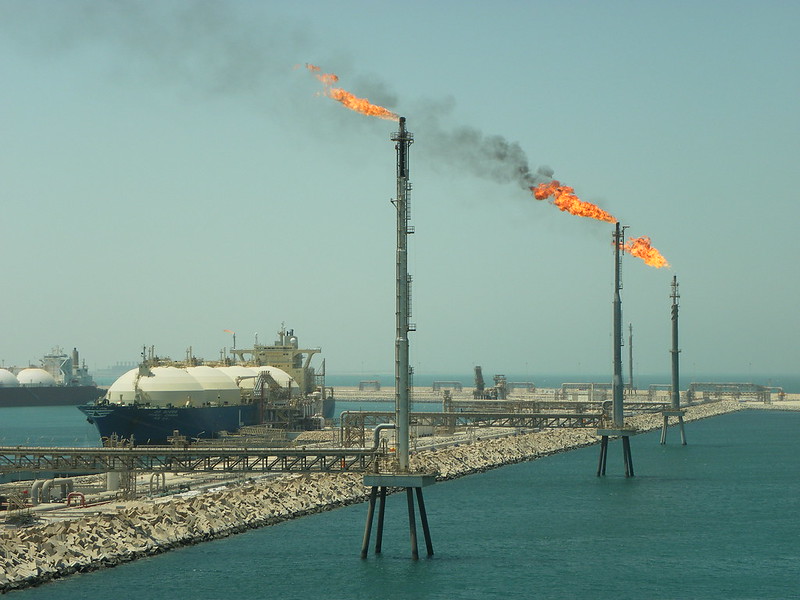Ways of Price Making, Inflation, and Energy Price Shocks

This post was originally published on the Law and Political Economy blog as part of a symposium on inflation.
Energy prices have been much in the news over the past several months, occupying a prominent place in mainstream discussions of inflation. Higher prices for oil, natural gas, coal, and electricity are all pushing up inflation across the economy, dampening consumer demand, canceling out wage gains, and compounding the burdens facing working families and the poor as they seek to recover from the pandemic. And this is happening all over the world, with especially severe consequences for the poorest countries. Some have suggested parallels between the current moment and the 1970s, when two oil price shocks fueled price increases across the economy, producing a potent mix of inflation and economic stagnation.
Needless to say, the current energy price shocks, like those of the 1970s, cannot be explained by recourse to standard arguments about the money supply, manifest in recent claims of too much stimulus, as the key driver of inflation. While we can debate the precise contribution of the current energy price shocks to the increase in prices across the economy, it is clear that if we want to understand the broader dynamics driving inflation we need to look carefully and critically at prices in key sectors such as energy, and how those “systemically significant prices” are actually made and flow through the rest of the economy.
The Capacity Story
How then do we explain what is currently happening with energy prices? In the early days of the current price shocks, fossil fuel boosters blamed clean energy and climate policy. One columnist from the Wall Street Journal asserted just before the Glasgow climate summit that it was time to ask “some big boy questions” about our rush to renewable energy. Even today, some commentators are still pushing the false narrative that the current energy price shocks are a product of climate policy. In fact, it is abundantly clear that this is a fossil fuel energy crisis and, primarily, a natural gas crisis that is mainly affecting Europe.
To be sure, oil price benchmarks are up significantly compared to their all-time lows during the pandemic when prices actually went negative in April 2020. In recent weeks, the key West Texas Intermediate crude benchmark hit a seven-year high, with some analysts expecting a return to $100 per barrel later in the year. But these prices are still way below their highs in 1979-80 and 2007-08. And much of the current supply crunch can be explained by the substantial drop in exploration and production after the oil price crash in 2014 and another big drop during the pandemic — cycles of disinvestment that are now being rapidly corrected in a new expansionary phase of oilfield development.
Natural gas prices in Asian and North American markets were also up substantially in 2021 but have moderated in recent months. In the U.S., expectations of a warmer winter and increased production have pushed prices down by 40% from their October highs. In Asia, significant imports of liquefied natural gas (LNG) during the shoulder months of fall have resulted in high inventories and stable prices as the region heads into winter. Indeed, China’s Sinopec just released substantial LNG cargoes to the broader market — a sure sign that China is comfortable with its current levels of gas stocks.
Not so in Europe, where natural gas prices have soared to all-time highs, up an astonishing 800% over the last year. As of December 2021, natural gas prices in Europe were more than ten times higher than prices in the United States. With a colder than expected winter now kicking in, ongoing geopolitical concerns regarding a possible Russian invasion of Ukraine, uncertainty about the Nord Stream 2 pipeline, and a decision by France to take 10% of its nuclear capacity off line in January, the continent is looking at very high prices for the foreseeable future.
Most of the commentary on soaring natural gas prices has focused on supply shortfalls and bottlenecks as economies emerge from the pandemic, natural gas storage levels that are far below seasonal norms, lower than expected wind power, and the geopolitics around Russian gas (which makes up close to one-third of European gas supply). It should be obvious that none of this can be traced in any direct way to standard claims about inflation and the money supply. But it is also a mistake to suggest that this is simply the result of supply shortfalls in the face of surging demand.
Ways of Price Making
In fact, there are important aspects of these recent price shocks that stem directly from the choices governments have made about how to price energy. To understand the scale and scope of these price increases, in other words, we also need to look at the rules that have been adopted to govern the specific ways of price making in natural gas and electricity markets. Two policy choices in particular have contributed to the current energy crisis.
First, the decision to liberalize natural gas markets in Europe and to rely upon spot markets for natural gas (rather than long-term contracts indexed to the price of oil) has put Europe at the mercy of a fractured and politically charged regional natural gas market. This is happening at the same time that climate policy is driving a shift from coal to natural gas and in the face of a colder than expected winter. The global trade in LNG cannot make up the difference, reflecting the challenges of transporting natural gas, which is far more difficult and expensive to transport than oil, and the large, lumpy investments in fixed capital needed to increase global LNG capacity.
The EU decision to move away from long-term contracts stems from a conviction that liberalized gas markets will save consumers money, as well as the belief that a move away from long-term contracts will make it more difficult to secure financing for new natural gas assets, which will help achieve EU climate commitments. While we can debate the wisdom of these policy choices for the long term, what is clear is that the move away from long-term contracts indexed to the price of oil has left Europe highly exposed to short-term volatility in spot markets for natural gas.
The second major policy choice that is driving the current energy price shocks in Europe has to do with the design of European electricity markets. Like the organized wholesale electricity markets in the United States, the EU has adopted a specific auction design for its power markets that relies on a single clearing price (a so-called uniform clearing price auction design). This design allows the last increment of generation needed to meet demand to set the clearing price. All other generators that submitted lower priced offers then receive that clearing price. Because expensive gas generation is almost always on the margin setting the clearing price, the massive increases in natural gas prices are driving electricity prices to unprecedented heights. Indeed, electricity prices in Germany and Spain are hitting all-time highs, up more than six-fold compared to a year ago. And, just for the record, although some have pointed to historically high prices for emissions allowances in the European Union’s Emissions Trading Scheme as a major factor in electricity price increases, the IEA estimates that the contribution of high natural gas prices is roughly eight times bigger than the impact of high carbon prices.
Indeed, the fact that very high gas prices are translating directly into very high clearing prices in European electricity markets is one of the main reasons why coal-fired electricity has increased substantially in the last year (up 20% in the EU). Simply put, as the clearing price in the electricity auctions increases, it becomes much more valuable to burn coal for electricity because these generators—along with all of the other infra-marginal generators—will receive the high clearing price set by expensive natural gas plants. And this is true even with a high carbon price. So while news reports suggest that the shift back to coal is all being driven by supply and demand and the historic shortages we are seeing in natural gas, it is also being driven by the particular rules that govern the way prices are made in the electricity markets.
No Ordinary Markets
In many ways, the current energy price shocks in the EU reflect a set of policy choices that has created short term dependence on natural gas and an increasingly tight coupling of the natural gas and electricity systems. Disruptions in one inevitably spill over to the other. We saw a version of this in Texas last winter in the wake of Winter Storm Uri, when power prices hit extraordinary levels in large part because of the failure of the natural gas system to deliver gas where and when it was needed, combined with a persistent failure to invest in winterization of (mainly gas-fired) power plants.
What the current energy price shocks also make clear, however, is that these are not ordinary markets (if ever there were such a thing) and that reliance on the price system to sort it all out is an illusion. Energy is a necessity, and the natural gas and electricity systems are key systems of provisioning for the economy as a whole and for everyday life. When prices for electricity and natural gas are allowed to rise to unprecedented levels, they create huge burdens for the poor, many of whom are already struggling with energy burdens that require brutal tradeoffs between eating and paying utility bills. The various (albeit inadequate) pandemic relief measures regarding utility bill assistance and shutoff moratoria in the US and recent efforts by the EU and some of its member states to step up their assistance to low-income households in the face of skyrocketing energy prices makes clear that these governments recognize that energy is not simply a commodity that can be left to the vagaries of the market. Whether this will translate into a deeper questioning of the expansive neoliberal commitments to prioritize competition and markets in energy over the last forty years remains to be seen. But as the clean energy transition accelerates, these broader questions of politics and price making should be front and center.
Indeed, one of the great advantages of renewables is that they have no fuel costs and are not hostage to global markets in the way that traditional fossil fuels like oil and gas are. In that respect, they carry with them the potential for a new politics of energy built around price stability, universal access, and a duty to serve all customers. But that potential will only be realized if the public demands it and governments enforce it. As the clean energy transition accelerates, massive new clean energy companies have emerged over the past decade — a new class of “clean energy supermajors” that now enjoy market capitalizations rivaling and even exceeding those of the oil majors. As they continue to grow and as we electrify and work to decarbonize larger segments of everyday life, we can be virtually certain that their approach to the rules governing energy price-making will be driven by their underlying commitments to their shareholders, rather than any sort of commitment to what used to be called the public interest.
Reader Comments
One Reply to “Ways of Price Making, Inflation, and Energy Price Shocks”
Comments are closed.







While reliance on specific market designs in these two energy commodities probably have contributed to this price volatility, other more realistic market designs can address these problems. Natural gas (fossil methane) prices have been decoupled from oil prices since the early 1990s so tying them to oil is not an accurate measure of the commodity’s value. Long term contracting is a means of stabilizing these prices, but from a climate change mitigation perspective, leaving fossil methane to the spot market may be one of the best ways to encourage electrification. Rooftop solar took off in California as a means for consumers to lock in bills versus the steadily rising electric rates. For electricity markets, the premiums in the single-price hourly markets arise substantially from scarcity pricing as much as from natural gas prices. For these hourly markets to achieve the goal of encouraging generation investments, there must be many hours where generators can extract scarcity rents from consumers. This is the underlying flaw in this approach. It can be easily fixed by using powerplant turnkey auction markets instead that put control of generation pricing in the hands of the load serving entities instead. So the problems are not about markets in general but rather about how the markets are specifically designed.